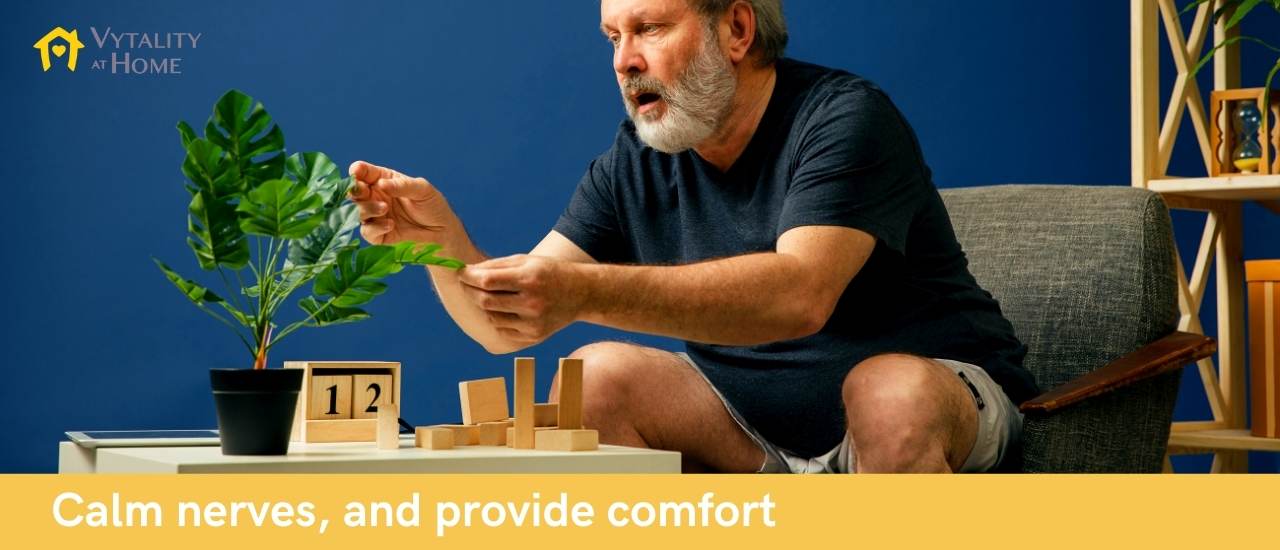15 stimulating sensory activities for seniors with dementia or Alzheimer’s
As part of our home care visits, our caregivers always have the time to engage in activities with those they care for. Time spent together on a crossword, a game of chess, discussing the news or just doing a jigsaw for fun provides engagement, cognitive stimulation, social stimulation and a shared experience. For seniors living with dementia and Alzheimer’s, some of these activities may be too challenging or just not suitable.
So, if you’re caring for someone with memory or cognitive impairment, try something different. There is considerable benefit in shared sensory activities that involve their sense of touch and smell. Many seniors with dementia often experience feelings of anxiety, agitation or anger. Enjoyable activities with a sensory element can really help them to keep calm or relax. As Daily Caring magazine says:
“Sensory therapy is an effective method for reducing anxiety, calming nerves, and providing comfort. Seniors use simple touch-based activities to occupy their hands and minds in safe, soothing ways.”
Busy hands
As anyone who cares for a loved one with dementia knows, many show their anxiety levels through almost constant movement of their hands. This can be repeatedly rubbing hands together, plucking at clothing, or handling a familiar object over and over, such as a purse. Sensory activities can help keep busy hands occupied, or you can provide fidget objects – more on these later!
Success!
Activities for those with dementia should always have a successful outcome, and be failure-free. There is no right or wrong way to do it, just the satisfaction of doing it. If the activity can be perceived as being useful too, all the better.
Bearing all these points in mind, here are our 15 great sensory activity ideas for those living with dementia to enjoy with their caregiver.
1. Baking
Baking for fun is a perfect activity to share with those in the earlier stages of dementia. Those with dementia can:
-
-
- share memories of favourite cakes or pies
- look through their old recipe books
- use their hands to measure, mix, knead and roll
- smell the ingredients and share memories that might arise
- eat the results!
-
Make sure that the whole baking experience is within their capabilities and that it doesn’t place them in danger from sharp utensils or hot ovens.
2. Folding towels
The simple act of folding towels is calming and soothing, and gives a feeling of contributing to the household chores. It doesn’t matter if the folds are not straight, as this activity is primarily about taking part and keeping hands busy and mobile. Having said that, it is also a lovely result to have a pile of clean, folded towels to admire and then put away!
3. Pattern blocks and boards
This is a toy you may recognise from childhood: a set of coloured geometric shapes and cut-out outlines to slot them into. There is an element of ‘right or wrong’ involved in this activity, as some shapes will need to fit into particular slots. If this is an issue, simply go free-form and let everyone involved create their own Picasso masterpiece!
4. Knitting or crochet
If your loved one enjoyed knitting in the past, they may have simply stopped because patterns became too hard to read or arthritic hands struggled with small needles. Rekindle their love with large gauge needles and brightly-coloured yarns, and let muscle memory do the rest. The results may be a little ragged and wonky, but the repetitive action is often soothing and again, keeps fidgeting hands busy.
5. Organizing the junk drawer
Let’s be honest, every home has a junk drawer! Ask for help from your loved one in sorting it out. Take the whole drawer out and place it on a table, and put a tray at the side where sorted items can be placed. It’s amazing what memories will be triggered by items in the drawer, from the discarded ‘gifts’ from Christmas crackers to mystery keys for long-gone locks. Allow plenty of time for this activity as you’ll spend as much time as your senior saying “Now what was that used for?!”
6. Shuffling and arranging cards
Cards are a great resource for family caregivers and almost anyone who is housebound. Long after the ability to play structured games such as bridge has gone, there are still simple fun to be had with games of snap or suit matching the cards. And when these in turn become too confusing, just the simple act of shuffling cards and laying them out has a soothing and satisfying feel for those with dementia.
7. Make your own fidget sensory box
This is like a “lucky dip” of items that can be squeezed, stroked, felt and fiddled with, just for the sheer pleasure of it. You might like to include items such as:
-
-
- soft plastic balls that can be squeezed
- old zippers
- buttons, either sewn in a row or strung on cord
- wind-up toys that move in some way
- contrasting fabric samples – fur, silk, faux leather, bright cotton print
- smooth pebbles or turned wood eggs (not too small)
-
One of our team has a box like this created solely from giveaway items picked up at conferences, trade shows and other corporate events. These include badge lanyards with clips, stress balls, toy figures, branded puzzles, keyrings, and even bamboo socks!
8. Sort the pen pot
Another activity that is useful and purposeful. Ask your senior to help test and sort collections of pens into those that work and those that don’t. This has a real benefit too – no more grabbing a pen to write something down, and discovering it’s run out of ink or is broken!
9. No-paint painting
Otherwise known as aqua-painting, colourful pictures are revealed when gently ‘painted’ with a paintbrush dipped in plain water. The colour fades as the water evaporates, so you can paint them again and again. Find these in children’s toys store.
10. Cuddle cushion or sensory blanket
This is a scaled-up version of the toys you can buy for babies (and for puppies!) with different textures of fabric – crinkles, bobbles, smooth, shiny. A standard cushion or washable blanket can be customised with extra textures such as faux leather or crochet, removable strung bead loops, velcro’d animal shapes, sequin fabric and button-down flaps, whatever you know your senior enjoys. Keep one side as a warm, fluffy surface that can be cuddled close for comfort. One dementia charity recommends adding a clear plastic pocket for photos, but that might not be suitable if you want your cushion or blanket to be machine washable for hygiene.
11. Scent boxes
Familiar scents can often trigger memories more effectively than visual clues. You can make your own with kitchen ingredients to guess using either small clean plastic containers, small sealable plastic bags stapled to card, or samples tied in small muslin bags or cotton squares. Think cloves, cardamon, roasted coffee beans, lemon peel, cinnamon bark, vanilla pods, etc. You can also use drops of essential oils on small cotton pads, such as peppermint, eucalyptus and orange. Use your imagination to think how other smells might trigger other memories, such as charred wood, fresh pine needles and BBQ sauce for camping holidays.
12. A familiar item to hand
Many of us will know the feeling of needing to check we have personal items with us, from patting our passports in a pocket at an airport, to checking handbags for house keys and mobile phone (preferably before we close the front door…) Put coins, toy when they feel the need.
13. Wooden puzzles
Clear, colourful wooden puzzles that have chunky pieces and create a colourful picture are very satisfying to handle and to complete. Latch boards or boxes include lots of different closure hardware from bolts to hooks, often opening to reveal hidden picture or compartments with items in. Closing and opening each will be a success in itself, making these very satisfying activities that are also very durable.
14. Sensory pouches / squish bags
A very clever idea that young grandchildren will love too! Squish bags are zip lock plastic bags filled with small objects suspended in a squishy gel. They combine visual stimulation of colour with the contrast of textures between the object and the gel they are suspended in. They are also easy and cheap to make.
15. A day at the beach
Bring that seaside experience inside with a DIY beach, including sea shells, water, pebbles and plastic toy crabs and fish. Your ‘beach’ can be a simple tray or washing up bowl on a tabletop, or think bigger with a kids plastic play sand pit outside on the deck complete with buckets and plastic spades. Why not make a day of it too – pop on sunshades, a hat and a CD of sea sounds, and perhaps even take off shoes and socks for a seated ’paddle’ with feet in a bowl of water – with a strand of seaweed!
Home care for those with dementia or Alzheimer’s
At Vytality at Home, we offer our exceptional home care services for those living with dementia, offering a welcome two hours or more of respite care for those caring for them too. Call us to discuss your requirements.




